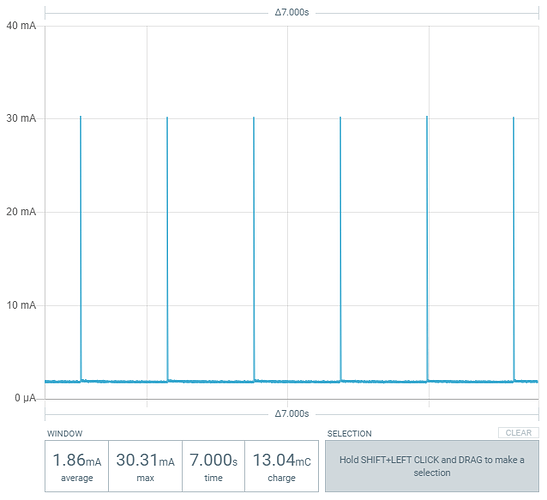Ah it appears I spoke too soon! I forgot to put the all important LoRa radio sleep code in the BLE sketch. With the above code, including the below snipped in setup(), with TX power set to -40 the average current of just the core module including TX peaks over a 1 minute interval is ~23.5uA! Excellent. FYI having TX power set to 4 all the time leads to average current of ~42uA. Connected average current is ~205uA for -40, and ~266uA for +4, Advertisement interval for both is set to ~1.2s.
For the sake of others who might find this thread, here is my test code in its entirety:
/**
@file ble_uart.ino
@author Bernd Giesecke ([email protected])
@brief BLE example shows how to implement UART over BLE
@version 0.1
@date 2020-07-27
@copyright Copyright (c) 2020
@note RAK4631 GPIO mapping to nRF52840 GPIO ports
RAK4631 <-> nRF52840
WB_IO1 <-> P0.17 (GPIO 17)
WB_IO2 <-> P1.02 (GPIO 34)
WB_IO3 <-> P0.21 (GPIO 21)
WB_IO4 <-> P0.04 (GPIO 4)
WB_IO5 <-> P0.09 (GPIO 9)
WB_IO6 <-> P0.10 (GPIO 10)
WB_SW1 <-> P0.01 (GPIO 1)
WB_A0 <-> P0.04/AIN2 (AnalogIn A2)
WB_A1 <-> P0.31/AIN7 (AnalogIn A7)
*/
#include <Arduino.h>
#include <bluefruit.h>
#include <SX126x-RAK4630.h>
// Forward declarations for functions
void ble_connect_callback(uint16_t conn_handle);
void ble_disconnect_callback(uint16_t conn_handle, uint8_t reason);
/**
@brief BLE UART service
@note Used for BLE UART communication
*/
BLEUart g_BleUart;
/** Flag if BLE UART client is connected */
bool g_BleUartConnected = false;
/**
@brief Arduino setup function. Called once after power on or reset
*/
void setup()
{
lora_rak4630_init();
Radio.Sleep();
// Initialize built in green LED
// pinMode(LED_BUILTIN, OUTPUT);
// digitalWrite(LED_BUILTIN, HIGH);
// Initialize Serial for debug output
Serial.begin(115200);
// Wait for USB Serial to be ready or terminal to be connected
time_t timeout = millis(); // Timeout in case the system runs on its own
// Waiting for Serial
// while (!Serial)
// {
// if ((millis() - timeout) < 5000)
// {
// // Blink the LED to show that we are alive
// delay(100);
// digitalWrite(LED_BUILTIN, !digitalRead(LED_BUILTIN));
// }
// else
// {
// // Timeout while waiting for USB Serial
// break;
// }
// }
Serial.println("================================");
Serial.println("RAK4631 BLE UART example");
Serial.println("================================");
// Config the peripheral connection with maximum bandwidth
// more SRAM required by SoftDevice
// Note: All config***() function must be called before begin()
//Bluefruit.configPrphBandwidth(BANDWIDTH_MAX);
Bluefruit.configPrphConn(92, BLE_GAP_EVENT_LENGTH_MIN, 16, 16);
Bluefruit.begin(1, 0);
Bluefruit.autoConnLed(false);
// Set max power. Accepted values are: -40, -30, -20, -16, -12, -8, -4, 0, 4
Bluefruit.setTxPower(4);
// Set the BLE device name
Bluefruit.setName("RAK4631_UART1");
Bluefruit.Periph.setConnectCallback(ble_connect_callback);
Bluefruit.Periph.setDisconnectCallback(ble_disconnect_callback);
// Configure and Start BLE Uart Service
g_BleUart.begin();
// Set up and start advertising
// Advertising packet
Bluefruit.Advertising.addFlags(BLE_GAP_ADV_FLAGS_LE_ONLY_GENERAL_DISC_MODE);
Bluefruit.Advertising.addTxPower();
Bluefruit.Advertising.addName();
/* Start Advertising
- Enable auto advertising if disconnected
- Interval: fast mode = 20 ms, slow mode = 152.5 ms
- Timeout for fast mode is 30 seconds
- Start(timeout) with timeout = 0 will advertise forever (until connected)
For recommended advertising interval
https://developer.apple.com/library/content/qa/qa1931/_index.html
*/
Bluefruit.Advertising.restartOnDisconnect(true);
Bluefruit.Advertising.setInterval(1952, 1952); // in unit of 0.625 ms
Bluefruit.Advertising.setFastTimeout(30); // number of seconds in fast mode
Bluefruit.Advertising.start(0); // 0 = Don't stop advertising after n seconds
}
/**
@brief Callback when client connects
@param conn_handle: Connection handle id
*/
void ble_connect_callback(uint16_t conn_handle)
{
(void)conn_handle;
g_BleUartConnected = true;
Serial.println("BLE client connected");
}
/**
@brief Callback invoked when a connection is dropped
@param conn_handle: connection handle id
@param reason: disconnect reason
*/
void ble_disconnect_callback(uint16_t conn_handle, uint8_t reason)
{
(void)conn_handle;
(void)reason;
g_BleUartConnected = false;
Serial.println("BLE client disconnected");
}
/**
@brief Arduino loop. Runs forever until power off or reset
*/
void loop()
{
delay(5 * 1000);
// Forward anything received from USB Serial to BLE UART
if (Serial.available() && g_BleUartConnected)
{
g_BleUart.print(Serial.readString());
}
// Forward anything received from BLE UART to USB Serial
if (g_BleUart.available())
{
Serial.print(g_BleUart.readString());
}
}
I had an issue using the semaphore framework you linked previously and a device being unable to connect using it, but FYI I found the delay() method (while much less graceful), actually has an extremely similar current consumption profile and should do for my purposes.
Most of this investigation is ongoing to evaluate the general usefulness of the RAK4631 core module @nmcc, but more specifically I do want to implement similar functionality to what Beegee has done regarding configuring a LoRa/LoRaWAN node via BLE. Luckily, with only 24uA draw to have BLE advertisements, very glad to say this is possible.






